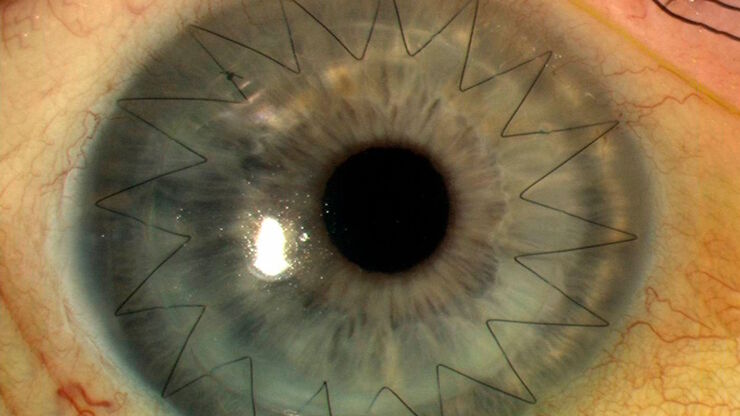Loading...

Ophthalmology Case Study: Corneal Transplantation
Learn about the use of intraoperative Optical Coherence Tomography in Corneal Transplantation and how it helps achieve correct positioning of donor tissue.
Loading...
![[Translate to chinese:] The principle of the FusionOptics technology [Translate to chinese:] The principle of the FusionOptics technology: Of the two separate beam paths (1), one provides depth of field (2) and the other high resolution (3). In the brain, the two images of the sample are merged into a single, optimal 3D image (4).](/fileadmin/_processed_/3/c/csm_csm_fusionoptics_pcb-inspection_e71950a5dd_271afc1b85.jpg)
FusionOptics融合光学(徕卡专利技术)高分辨率和大景深结合
人类对视觉环境的感受,80%通过视觉感知获得。如果没有空间视觉,我们几乎无法确定方向。我们的视觉皮质和大脑皮层通过复杂的过程,巧妙地处理着从眼睛看到的图像信号。最近几十年,神经科学已经大量了解该过程。故由徕卡显微系统、苏黎世大学神经信息学研究所和瑞士联邦理工学院共同开展的一项研究,显示了我们的大脑如何灵活有效地结合视觉信号创造出最佳空间图像。研究结果为立体显微技术创新奠定了基础,该创新从分辨率和聚…
Loading...
![[Translate to chinese:] Strain from using a microscope can lead to musculoskeletal pain. [Translate to chinese:] Strain from using a microscope can lead to musculoskeletal pain.](/fileadmin/_processed_/b/1/csm_AdobeStock_musculoskeletal_pain_893e89f2c0.jpg)
如何使显微镜工作场所符合人体工学
对于每天使用显微镜工具的人来说,显微镜具有重要影响。显微镜对人体有着很高的要求,需要我们集中注意力,运用肌肉从事大量稳定活动。
在此次采访中,Leica Microsystems的高级产品经理Clinton Smith谈到了如何缓解可能出现的紧张和压力,如何创造符合人体工学的工作场所来帮助显微镜用户舒适地工作,以及如何提高生产率。
Loading...
![[Translate to chinese:] Lifetime-based multiplexing in live cells using TauSeparation. Mammalian cells expressing LifeAct-GFP (ibidi GmbH) and labelled with MitoTracker Green. [Translate to chinese:] Lifetime-based multiplexing in live cells using TauSeparation. Mammalian cells expressing LifeAct-GFP (ibidi GmbH) and labelled with MitoTracker Green. Acquisition with one detector, intensity information shown in grey. The two markers can be separated using lifetime information: LifeAct-GFP (cyan), MitoTracker Green (magenta). Image acquired with STELLARIS 5.](/fileadmin/_processed_/8/7/csm_Lifetime-based_multiplexing_in_live_cells_using_TauSeparation_8fa372a6b9.jpg)
可重复性、协作和新成像技术的力量
在本次网络研讨会上,您将了解到影响显微镜可重复性的因素,有哪些资源和举措可用于改善显微镜教育并提高其严谨性和可重复性以及研究人员、成像科学家和显微镜供应商之间的合作如何推动创新和采用新技术。
Loading...
![[Translate to chinese:] Branched organoid growing in collagen where the Nuclei are labeled blue. To detect the mechanosignaling process, the YAP1 is labeled green. [Translate to chinese:] Branched organoid growing in collagen where the Nuclei are labeled blue. To detect the mechanosignaling process, the YAP1 is labeled green.](/fileadmin/_processed_/a/e/csm_Branched_organoid_growing_in_collagen_083254eb44.jpg)
检查癌症类器官的发展进程
德国慕尼黑工业大学的Andreas Bausch实验室研究细胞和生物体中不同结构和功能形成的细胞和生物物理机制。他的团队设计了新的策略、方法和分析工具,以量化微米和纳米等级的发展机制和动态过程。关键研究领域包括干细胞和类器官,从乳腺类器官到胰腺癌类器官,以更好地了解疾病模型。
Loading...
![[Translate to chinese:] Advanced technologies support neurosurgical teaching. Image courtesy of Dr. Florian Bernard. [Translate to chinese:] Advanced technologies support neurosurgical teaching. Image courtesy of Dr. Florian Bernard.](/fileadmin/_processed_/b/0/csm_Advanced_technologies_support_neurosurgical_teaching_9ba4ad70a6.jpg)
3D、AR和VR技术在神经外科教学领域的应用
尽管拥有强大的传统教学方法,但神经外科解剖学依然是一门艰难晦涩的课程。因为这些传统教学方法并不能确保良好的知识传授效果,尤其是经验丰富的外科医生的提示和技巧。模拟解剖和现场教学等新的方法有助于提高学习质量,同时满足数字化程度更高的新一代实习医生的需求。

![[Translate to chinese:] In vivo imaging of a mouse pial and cortical vasculature through a glass window (ROSAmT/mG::Pdgfb-CreERT2 mouse meningeal and cortical visualization following tamoxifen induction and craniotomy). Courtesy: Thomas Mathivet, PhD [Translate to chinese:] In vivo imaging of a mouse pial and cortical vasculature through a glass window (ROSAmT/mG::Pdgfb-CreERT2 mouse meningeal and cortical visualization following tamoxifen induction and craniotomy). Courtesy: Thomas Mathivet, PhD](/fileadmin/_processed_/6/3/csm_Mouse_pial_and_cortical_vasculature_f409d941d0.jpg)
![[Translate to chinese:] Mouse cortical neurons. Transgenic GFP (green). Image courtesy of Prof. Hui Guo, School of Life Sciences, Central South University, China [Translate to chinese:] Mouse cortical neurons. Transgenic GFP (green). Image courtesy of Prof. Hui Guo, School of Life Sciences, Central South University, China](/fileadmin/_processed_/2/a/csm_THUNDER_Imager_Mouse_cortical_neuron_9d4054774d.jpg)
![[Translate to chinese:] Cell counts for each biomarker were divided by total number of cells to give a percentage of biomarker positive cells out of total cells for each biomarker. [Translate to chinese:] Cell counts for each biomarker were divided by total number of cells to give a percentage of biomarker positive cells out of total cells for each biomarker.](/fileadmin/_processed_/5/3/csm_Cell_counts_for_biomarkers_with_Cell_DIVE_ee648b397a.jpg)